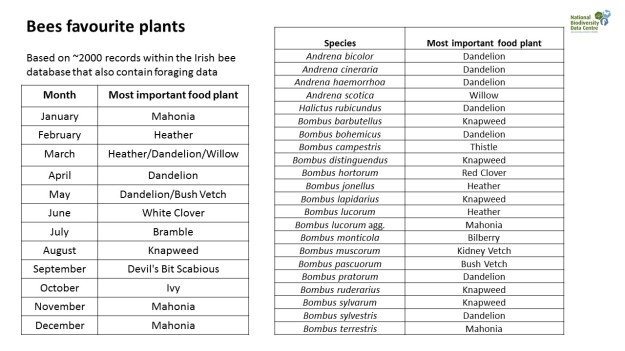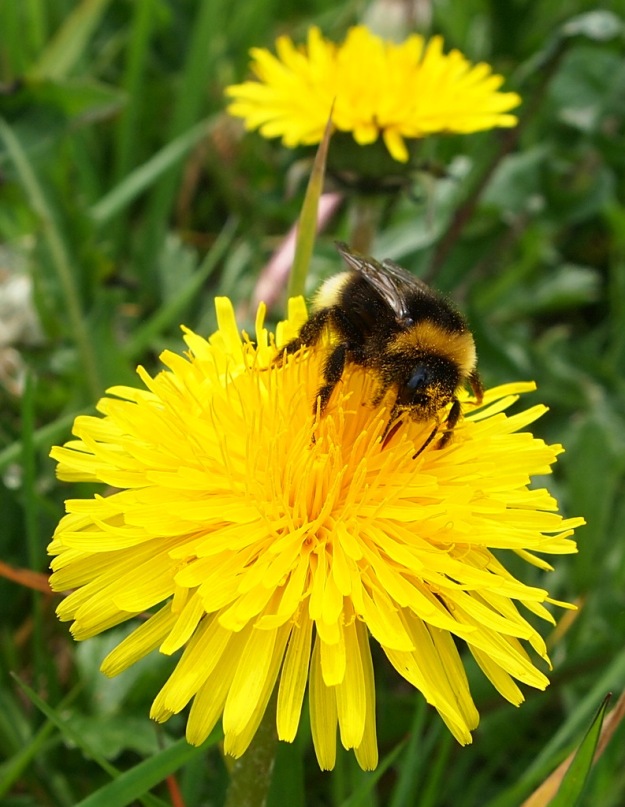At this time of year as queen bees are beginning to emerge from hibernation it is really important that there is food for them. Yesterday, I received this fascinating table in my inbox. The National Biodiversity Data Centre collects records of bees and the flower the bee was feeding on. With exception of Mahonia all the plants are native. It is also clear that dandelions are important. Here’s a couple of things you could do this spring:
- Allow the dandelions to flower on your lawn before you cut it, or
- Leave a corner of your lawn uncut, so that the dandelions can flower


Bumblebee on dandelion

Reblogged this on Wild Pollinator Gardens.
LikeLike
Thank you for your important information. It is another reason why I don’t want to encourage using the flower heads of the dandelion in recipes, they are so important to the bees. We need to learn also that when we are harvesting wild plants and flowers that we do so in an eco friendly way and not just pluck them everywhere in large quantities 🙂 Great photo too.
LikeLiked by 1 person
Good point:)
LikeLiked by 1 person
May I share on my blog?
LikeLiked by 1 person
Please do.
LikeLike
Do you get red dead nettle (Lamium purpureum) in Ireland? We get a lot of it here at the moment and the wild bees love it. Amelia
LikeLiked by 1 person
We do, but it’s more common in the eastern half of the country. I haven’t noticed any out yet. But I will keep an eye out in the little bit that grows nearby in a hedgerow
LikeLiked by 1 person
I think the favourite bee plants in my area are the wild roses, but they don’t bloom until June. Meanwhile, there are plenty of dandelions and willow to keep them happy.
LikeLiked by 1 person
I know here that the little Early bumblebee likes the wild roses which are also out around June.
LikeLiked by 1 person
Indeed – I think I will pot some dandelions up! Then I can see my bees enjoying themselves. Ma grows hers in the greenhouse especially for Fred the tortoise! xx
LikeLiked by 1 person
I bet Fred is very happy with his dandelion salad!
LikeLike
Native plants are hands down the bee’s best friend. For late winter/early spring food, I find miniature bulbs like croci and snowdrops see a lot of action. I might add Mahonia aquifolium to my planting wish list this spring, as it tolerates in my zone 5.
LikeLiked by 1 person
Have you seen wild bees use the Snowdrops? I’ve seen photos of honey bees using them but have not seen any bumbles on them yet.
LikeLike
I will have to pay closer attn this spring to see. We’re still buried under snow, esp. with this latest blizzard. Oh, boy!
LikeLiked by 1 person
Keep safe Eliza. We hear the weather is quite bad over there.
LikeLike
Biggest storm this year. Knee deep and blowing like crazy. It is pretty much over and it took me 2 hours to snow-blow the driveway with wind throwing it all back at me. I was caked head to toe with snow, like the abominable snowman!
LikeLiked by 1 person
A very imporant post! I am really enjoying your blog – I have just started my full time volunteer internship as a trainee countryside ranger with the National Trust at Bath Skyline and the majority of our conservation work is restoring and conserving the most amazing herb rich limestone wild flower meadows – an absoulte haven for pollinators and a rare beauty these days as we have so little of our natural wild flower meadow left! I haven’t even seen our sites in all their glory yet but I’m very excited for May and June to arrive – especially for all the inverts that it will attract. Iv just started blogging about the work that we do to make it all happen if you’re interested – my blog is going to get a lot more insect heavy as the spring gets going. Your courses sound great, I’d love to do one if I wasnt so far away. I would really like to start getting more involved in encouraging people to allow wild flowers to grow in their gardens and urban wild flower projects – anyway, you are great inspiration for me, so thanks for sharing!
Keep up the good work.
All the best,
Alice
LikeLiked by 1 person
Glad to be of inspiration Alice. It sounds like a great intership, and I will certainly take a look at your blog. And it sounds like a great place to work. Sadly native wildflowers are much in decline here too. I think gardeners have a great role to play here – both planting native and good non native pollen and nectar varieties.
LikeLiked by 1 person
Yes, I agree – I think it’s very important that people are encouraged to do at least a little bit to support our wildlife communities in their own spaces – and in our shared public spaces. Great to see people like you promoting it.
Alice
LikeLiked by 1 person
What an interesting post, thanks for the information. Funnily enough, I am not sure that I’ve ever seen a bee on a dandelion before!
LikeLiked by 1 person
They probably use them more at this time of year when there isn’t as much available.
LikeLike
Save the dandelions… save the bees… and butterflies!! And… the little kids blowing wishes!! 😉
LikeLiked by 1 person
Great seed dispersalers
LikeLike
Blow babies… BLOW!! 😉
LikeLiked by 1 person
Pingback: Six months in 17 for 2017 | Murtagh's Meadow